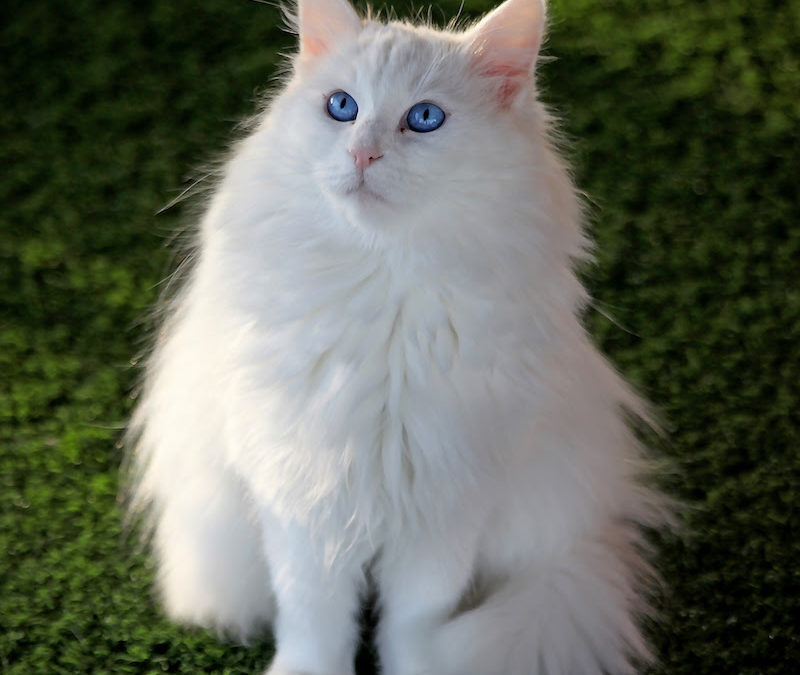The term “Endemic” comes from the Greek word “endemos” (indigenous). In addition
to being a region where scores of civilizations emerged and thrived throughout the
millennia. Anatolia has a rich geography where many rare species live. Located in
the crossroads of continents and featuring various climate zones, Turkey has a high
biological diversity. In particular, Anatolia, Mediterranean and Black Sea are home to
more species than many regions of the world. Turkey is home to nearly 3,000
endemic plant species and 12,500 endemic animal species.
Turkish Angora
Turkish Angora is a world-renowned cat breed that originates from Ankara as the
name implies. Turkish Angora was introduced to Europe in the 17 th century by sailors,
and by the 18 th century, it had already become the darling of the European nobility. A
very intelligent breed, Turkish Angora has pointed, large and wide ears with hairy tips
while its body hair is long and white. Turkish Angoras are known as strong, energetic
but elegant cats with medium long silky hair.
Kangal Dog
Kangal is a shepherd dog and watchdog breed originating from Turkey. Named after
the Kangal district of Sivas, this dog breed may be coming from Turkey but its fame
is global. An intelligent, bold and strong breed, Kangal dogs are very hard to train.
Usually described as shepherd dogs, the most distinctive characteristic of Kangal is
the extreme loyalty they have towards their owners and their strong protective
behavior. Particularly gentle to children, Kangals stand out as good fighters and very
effective guardians against predators such as wolves and jackals.
Van Cat
A precious and noble cat breed with either blue or amber eyes or one eye of each
color, Van cat is an accomplished swimmer. Endemic to the Van province of Turkey,
the kittens usually have one or two black spots between their ears. Van cats are
congenial, intelligent cats that actually love water, and indeed, swim.
Turkish Pointer
A hunting dog species unique to the Tarsus district of Mersin, Turkish Pointer’s most
distinctive characteristic is its nose, which looks like it has two noses. While it is not
aesthetically pleasing, this nose structure turns into an advantage during hunting.
Their unique nose structure improves their sense of smell while their narrow and long
heads are very strong. Special programs are still underway to ensure the continuity
of the race and preservation of the purity of this breed, which is called “Çatalburun”
(lit. “Forknose”) for its distinctly separated nostrils.
Angora Rabbit
Angora rabbit is known for its long and soft hair. Like the Angora goat and the Angora
cat, these purebred species are known to have spread to the rest of the world from
Ankara. Although the most famous Angora fiber was historically obtained from the
Angora sheep, from the early 18 th century on, Angora rabbit came to be better known
and preferred more thanks to its fibers, which keep warmer.
Kasnak Oak
Most widely found in the provinces of Konya, Afyon, Isparta and Kütahya, the wood
of Kasnak Oak is deemed precious and usually used to coat furniture and to
manufacture parquets.
Turkish Sweetgum
An endemic plant, Turkish Sweetgum is found the most in and around Muğla and
Fethiye. Resembling the Sycamore tree, Turkish Sweetgum can grow as high as 20
meters tall.
İspir Oak
İspir Oak is a species seen in Yozgat, Kastamonu and across the Eastern Anatolian
region. This oak species has very short leafstalks and can grow up to 6 to 7 meters
tall.
Datça Date Palm
Datça Date Palm is a tree species that grows particularly in the Teke Peninsula and
Datça up to 10-15 meters tall, bearing 1.5cm long fruits in color tones between yellow
and brown. Since they are adversely affected by strong winds, Datça Date Palm
trees usually survive in deep valleys.
Trojan Fir
Trojan Fir grows only on Mount Ida and can grow as high as 30 meters. A coniferous
tree, the Trojan Fir has an approximately 20cm-long cone at its top. The tree is fond
of humid soil and is known to grow rapidly under favorable conditions.
Eber Lupine (Piyam)
Discovered in 1982 by Turkish botanists, Eber Lupine is found only on the slopes of
Akşehir and Eber lakes in fragmented populations. Listed as critically endangered
because of the rapid decline in their numbers, Eber Lupine is a herbaceous plant with
yellow flowers that grow as high as 40-80cm. And its most important characteristic is
that it can yield three fruits from a flower.
Antalya Crocus
Another plant cited among the plants unique to Turkey, Antalya Crocus is a species
grows solely in Antalya, as the name suggests, dispersed in oak forests. Antalya
Crocus blossoms in October and keeps its flowers until December and usually grows
in elevations of 1,000 meters, putting forth new buds from the same root for many
years.
Royal Fern
Seen in humid soil across Turkey, and in the Black Sea Region in particular, the
Royal Fern is frequently encountered on side of streams, humid meadows and
marshes. Its branches extend to lengths between 1 to 2 meters with 4-6cm long
leaves. A perennial plant, Royal Fern starts to mature from July and August.
About Turkey
Located in the Mediterranean and connecting Asia and Europe continents that are
separated by famous Bosphorus, Turkey is a unique destination that welcomed last
year about 40 million tourists. The country that has always been a hub for cultural
interaction and home to varying climates inspires the visitors today with its history,
nature and gastronomy that reflect the diversity of civilizations for centuries. Located
at the crossroads of cultures, Turkey has a distinctive understanding of art & fashion
which is the synthesis of tradition and modernity and its extremely dynamic shopping
& entertainment life also attracts the visitors from all over the world.




